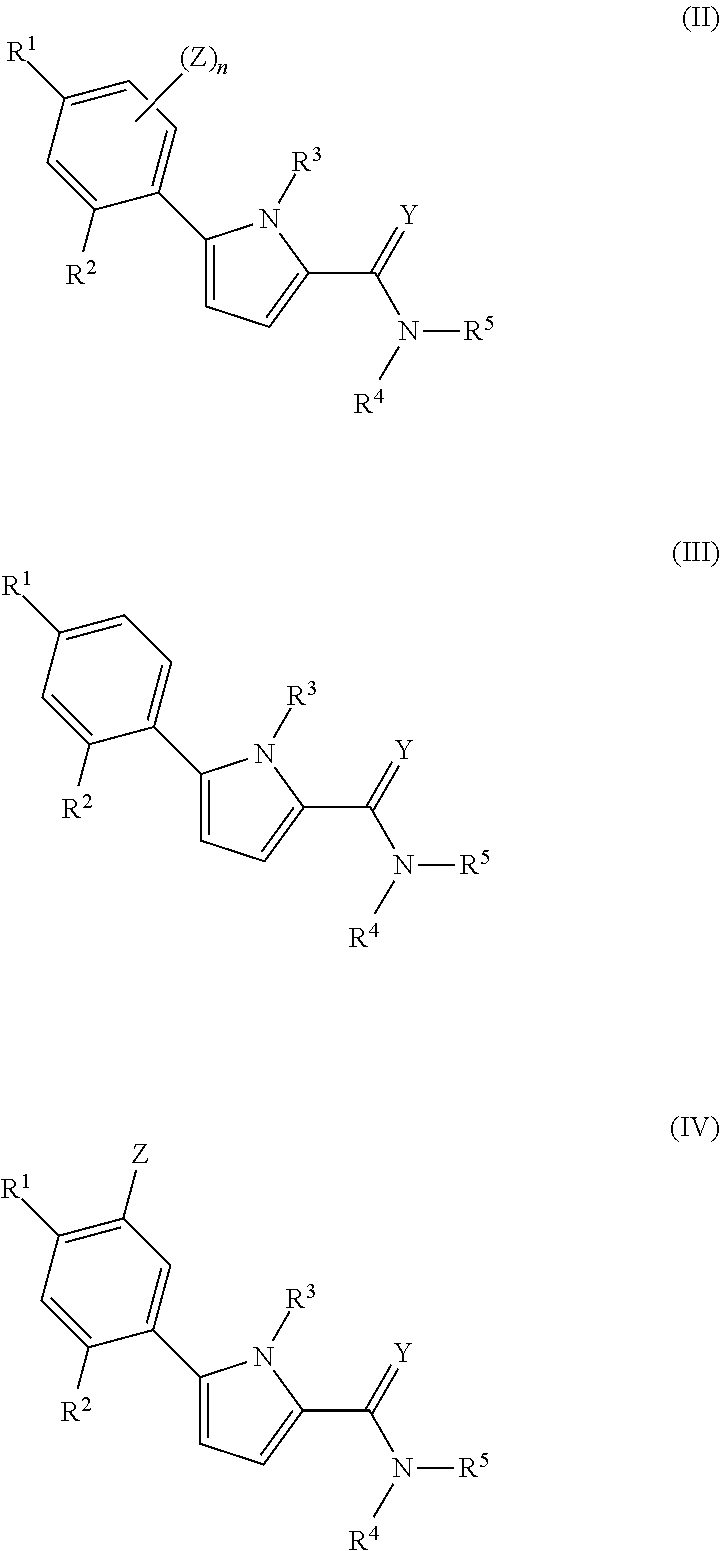Pyrrole compounds that modulate hsp90 activity
a technology of pyrrole compounds and hsp90, which is applied in the direction of biocide, immunodeficiency disorder, drug composition, etc., can solve the problems of unsatisfactory current chemotherapy, unfavorable treatment of patients with cancer, and inability to fully implement a therapeutic agent that acts on one molecular targ
- Summary
- Abstract
- Description
- Claims
- Application Information
AI Technical Summary
Benefits of technology
Problems solved by technology
Method used
Image
Examples
example 1
Synthesis of Compound 1
[0306]
[0307]STEP-1: To a stirred suspension of 0.20 g (0.53 mmols) of resorcinol boronic acid 1, 0.18 g (0.53 mmols) of bromopyrrole derivative 2, and 0.43 g (1.32 mmols) of CS2CO3 in 10 mL of dioxane in a round bottomed flask, was added 30 mg (53 μmols) of Pd2(dba)3 followed by 28 mg (0.106 mmols) of triphenylphosphine and the flask was thoroughly purged with argon. The mixture was then heated at 100° C. overnight and concentrated. Water work up using ethyl acetate to extract the product followed by chromatography afforded 0.28 g of the pure product 3.
[0308]STEP-2: a) Hydrolysis: A mixture of 0.28 g (0.47 mmols) of 3 and 100 mg (2.37 mmols) of LiOH was refluxed in the solvent mixture 5:5:3 (THF:MeOH:H2O, 13 mL) overnight and concentrated. The resultant aqueous mixture was acidified using 2M HCl till pH equaled 4 and the product was extracted with ethyl acetate to afford 0.25 g of the hydrolyzed product.
[0309]b) Amide formation: To a mixture of 0.25 g (0.44 mm...
example 2
Synthesis of Compound 3
[0313]
[0314]STEP-1: To a stirred solution of 0.33 g (1.51 mmols) of 1 and 0.50 g (3.02 mmols) of the boronic acid 2 in 15 mL of anhydrous dichloromethane was added 0.41 g (2.27 mmols) of Cu(OAc)2 followed by 0.25 mL (3.02 mmols) of pyridine at 0° C. The mixture was warmed up to room temperature and stirred over the weekend. Water workup and chromatography on silica gel afforded 0.11 g of the product 3 as colorless liquid.
[0315]STEP-2: To a suspension of 0.12 g (0.32 mmols) of the boronic acid 4 and 0.11 g (0.32 mmols) of product 3 from previous step, was added 0.27 g (0.81 mmols) of Cs2CO3 in 8 mL of dioxane and 2 mL of water and was stirred under argon atmosphere at room temperature. To the resultant mixture was added 5 mg of Pd2(dba)3 (8 mmols) followed by 10 mg of triphenylphosphine (32 μmols) and the flask was thoroughly flushed with argon. The flask was then heated at 100° C. overnight and concentrated. Water workup followed by concentration of the organi...
example 3
Inhibition of Hsp90
[0321]Hsp90 protein is obtained from Stressgen (Cat #SPP-770). Assay buffer: 100 mM Tris-HCl, Ph 7.4, 20 mM KCl, 6 mM MgCl2. Malachite green (0.0812% w / v) (M9636) and polyvinyl alcohol USP (2.32% w / v) (P1097) are obtained from Sigma. A Malachite Green Assay (see Methods Mol. Med., 85:149 (2003) for method details) is used for examination of ATPase activity of Hsp90 protein. Briefly, Hsp90 protein in assay buffer (100 mM Tris-HCl, Ph 7.4, 20 mM KCl, 6 mM MgCl2) is mixed with ATP alone (negative control) or in the presence of Geldanamycin (a positive control) or a compound of the invention in a 96-well plate. Malachite green reagent is added to the reaction. The mixtures are incubated at 37° C. for 4 hours and sodium citrate buffer (34% w / v sodium citrate) is added to the reaction. The plate is read by an ELISA reader with an absorbance at 620 nm.
PUM
 Login to View More
Login to View More Abstract
Description
Claims
Application Information
 Login to View More
Login to View More - R&D
- Intellectual Property
- Life Sciences
- Materials
- Tech Scout
- Unparalleled Data Quality
- Higher Quality Content
- 60% Fewer Hallucinations
Browse by: Latest US Patents, China's latest patents, Technical Efficacy Thesaurus, Application Domain, Technology Topic, Popular Technical Reports.
© 2025 PatSnap. All rights reserved.Legal|Privacy policy|Modern Slavery Act Transparency Statement|Sitemap|About US| Contact US: help@patsnap.com



